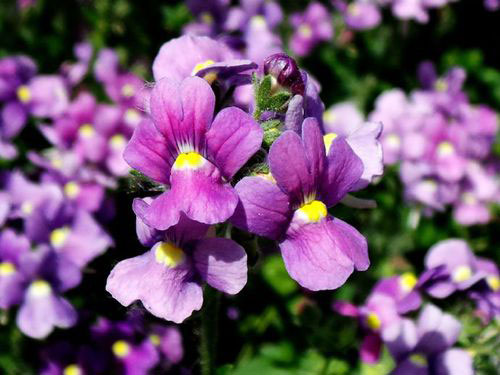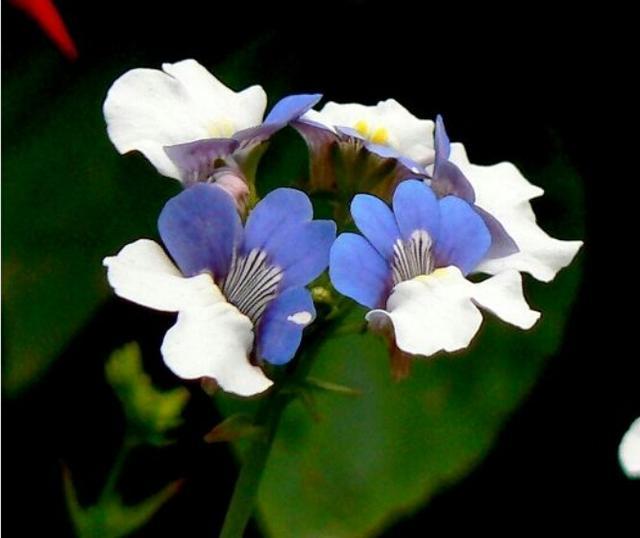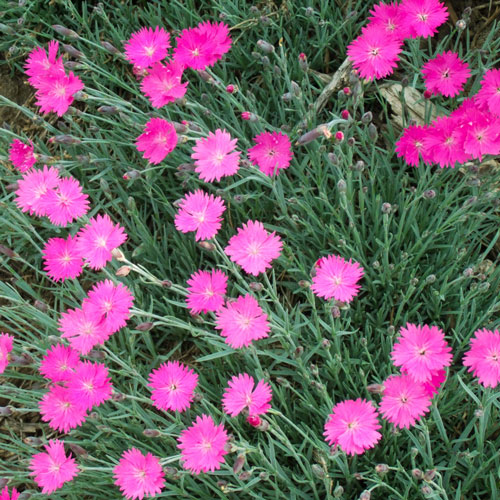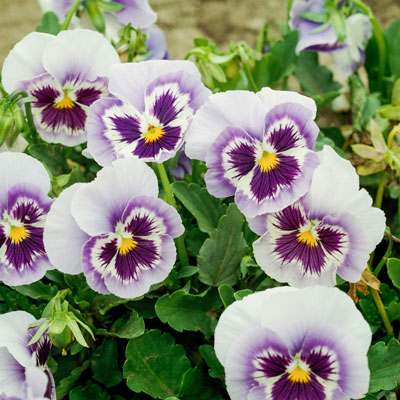Nemesia Profile
Written by Iris
Oct 13 2021

Nemesia Picture

Nemesia info
| Botanical Name | Scrophulariaceae |
| Common Name | Nemesia |
| Plant Type | Annual |
| Mature Size | 10-24 inches |
| Sun Exposure | Part to full sun |
| Soil Type | Rich soil, sandy |
| Soil pH | 5.5-7.5 |
| Bloom Time | Spring and Summer |
| Flower Color | White, red, pink, blue, orange |
| Hardiness Zones | 2-10 |
| Native Area | Africa |
Ecological habits of the Nemesia
How to grow and care for Nemesia
Nemesia Lighting Requirements
The nemesia plant will grow best in full sunlight, however these plants may bloom longer (particularly in warmer climates) if they do happen to get some afternoon shade.Nemesia Soil Care
Nemesias require a planting area with soil that's moist but well-drained, as well as rich in organic matter.Nemesia Watering
An abundance of water will lead to stem rot on a nemesia plant. While it's important to keep the soil moist for these particular flowers, be wary of over-watering.Nemesia Temperature & Humidity Care
Nemesia will grow best in cooler temperatures. In areas that have more mild summer temperatures, they can be expected to bloom from late spring until the first frost of the year, while in hotter climates they will look their best in early spring or fall. Be prepared for your nemesias to die back in the heat of summer. These plants can be grown as winter annuals in frost-free regions.Nemesia Fertilizer
Be sure to fertilize your mature nemesias using a a slow-release fertilizer. Apply the fertilizer once in the spring, or you can also choose a water-soluble fertilizer that can be applied twice monthly as they are actively growing.Varieties of Nemesia
Nemesia hybrids to buy as plants:
Nemesia ‘Berries and Cream’ is a pretty mixture of purple, mauve and whiteNemesia ‘Ice Pink’ has soft pink blooms
Nemesia ‘Rhubarb and Custard’ has exceptionally eye-catching bi-coloured flowers, purple on the upper half with a bright yellow centre fading to pale yellow on the lower part
Nemesia ‘Sunshine’ is bright yellow, fading to pale yellow on the outside of the petals
Nemesia ‘Tropical’ bears flowers of an unusual blend of orange and dark pink
Nemesia ‘Wisley Vanilla’ flowers are pure white with a yellow eye, borne on upright stems. Particularly strongly scented
Nemesias to grow from seed:
Common Pests/Diseases
Powdery Mildew:
A white powdery substance on leaves and stems is often fungal mold, also called powdery mildew. This starts in spring when conditions are still damp and humid, but temps have warmed. It will spread among the nemesias, but likely won’t affect other nearby plants. Avoid this fungus by watering plants at the roots, as overhead watering encourages spread and development.Aphids:
If you see a swarm of tiny black bugs around new growth when you’re nemesia troubleshooting, it is likely aphids. Blast them off with the water hose, trying to avoid wetting foliage unnecessarily. If they return, spray with an insecticidal soap or neem oil when the sun is not shining on the plants.Western Flower Thrips:
Tan scars on foliage and white scars on flowers are an indication of this pest. Look for a light brown pest with clear wings. Treat thrips with insecticidal soap before moving on to insecticide if soap spray is unsuccessful.Bacterial Leaf Spot:
Another problem caused by using overhead irrigation, greasy black spots start on lower leaves and move up the plant. Water at the roots to avoid this issue.Nemesia Companion Plants
Dianthus
The quintessential cottage flower, pinks are treasured for their grasslike blue-green foliage and abundant starry flowers, which are often spicily fragrant. Depending on the type of pink, flowers appear in spring or summer and tend to be pink, red, white, rose, or lavender, but they come in nearly all shades except true blue. Plants range from tiny creeping groundcovers to 30-inch-tall cut flowers, which are a favorite with florists. Foliage is blue-green.

Snapdragon
Few gardens should be without the easy charm of snapdragons. They get their name from the fact that you can gently squeeze the sides of the intricately shaped flower and see the jaws of a dragon head snap closed. The blooms come in gorgeous colors, including some with beautiful color variations on each flower. Plus, snapdragons are an outstanding cut flower. Gather a dozen or more in a small vase and you'll have one of the prettiest bouquets around. Snapdragons are especially useful because they're a cool-season annual, coming into their own in early spring when the warm-season annuals, such as marigolds and impatiens, are just being planted. They're also great for fall color. Plant snapdragon in early spring, a few weeks before your region's last frost date. Deadhead regularly for best bloom and fertilize regularly. Snapdragons often self-seed in the landscape if not deadheaded, so they come back year after year, though the colors from hybrid plants will often be muddy looking. In mild regions, the entire plant may overwinter if covered with mulch.
Pansy
From tiny, cheerful Johnny jump-ups to the stunning 3-inch blooms of Majestic Giant pansies, the genus Viola has a spectacular array of delightful plants for the spring garden. They're must-haves to celebrate the first days of spring since they don't mind cold weather and can even take a little snow and ice! They're pretty planted in masses in the ground, but also cherished for the early color they bring to pots, window boxes, and other containers. By summer, pansies bloom less and their foliage starts to brown. It's at this time that you'll have to be tough and tear them out and replant with warm-season annuals, such as marigolds or petunias. But that's part of their charm—they are an ephemeral celebration of spring!

Latest Updated
- Benefits of Bugleweed - 7 Science-backed Health Benefits
- Bugleweed Dangers & Side Effects - Is It Poisonous?
- How to Plant Evergreen Trees - What You Should Know
- When to Plant Evergreens - Grow Guide for Evergreen Trees
- 12 Wonderful Evergreen Shrubs for Your Garden
- 12 Popular Evergreen Plants with Pictures for Beginners
- When And How To Prune A Lilac Bush Like a Pro
- How to Grow & Care for Lilac Vine (Hardenbergia Violacea)
- Japanese Lilac Tree (Syringa Reticulata) Care & Propagation Guide
- Shumard Oak Pros and Cons - What to Know
Popular Articles
- Winter maintenance of Antirrhinum Majus
- How to Grow Terminalia Mantaly Tree
- How to Grow and Care for Crossostephium Chinense
- How to grow Antirrhinum Majus in spring
- Peristeria Elata (Dove Orchid) Profile: Info & Care Guide
- Underwatered Snake Plant (Sansevieria Trifasciata) - Signs And How To Fix
- How to Care for Brazilian Jasmine Plant (Mandevilla Sanderi)
- How to Grow & Care for Graptopetalum Purple Delight in Summer
- Rosa Chinensis (China Rose): Plant Growing & Care Tips
- How to Care for Baby Sun Rose (Aptenia Cordifolia)